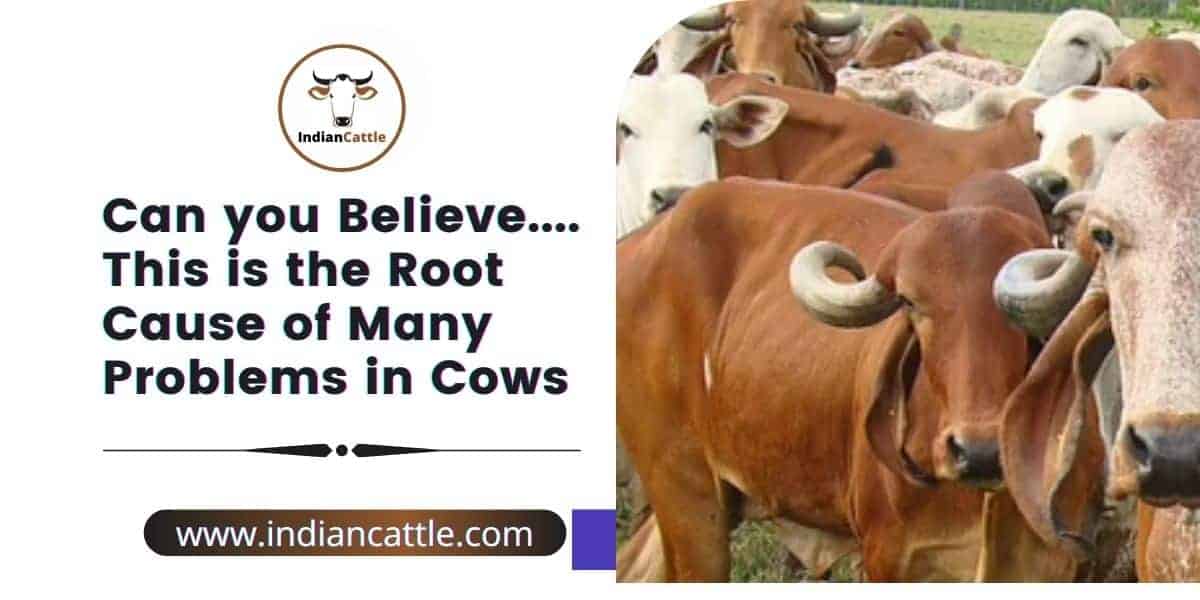
Cow Housing: Important to Ensure Cow Comfort, Optimum Fertility and Productivity
Cows are Not Human
- Their skin, body temperature, and the way body heat is lost are different from human and that the reason proper cow housing is important.
- Cowskin thickness is around 6 mm as compared to 0.7 mm in human. The cow’s skin provides greater insulation, and hence the way cows respond to changes in external temperature is different from humans. As a result, heat / cold tolerance in cows is superior to humans.
- Cows are social animals who like to be in groups. They get stressed when left alone and tied. Research has shown that when a cow has tied its blood sterol (a hormone that marks stress in animals) levels are at least three times higher than when kept untied or loose. Stress interferes with milk yields, expression of oestrus and fertility.
- When a cow is tied, it cannot express behavioral signs of oestrus, whereas when free, overt signs such as mounting other cows can lead to easy detection of animals in oestrus. Such cow housing increases fertility performance.
Cows Feet are Very Sensitive
- The four legs in cows carry enormous weight, which if not properly absorbed due to faulty floor may lead to lameness and hoof abnormalities. This is by far the most important cause of the culling of otherwise good cows.
- The barn floor should remain dry all the time. Floor wetness is an invitation to problems such as lameness and laminitis which complicate production and fertility.
- Hard cement concrete flooring without bedding on it is not comfortable for cows and act as the major origin of foot problems, especially in crossbred cows.
- Cement concrete flooring also radiates heat in tropical climates, and hence not suitable in warm areas.
- In contrast to concrete flooring, properly laid earthen floors are softer and more cost-effective.
Cows tied on a concrete floor are dirtier than cows let loose on the earthen floor
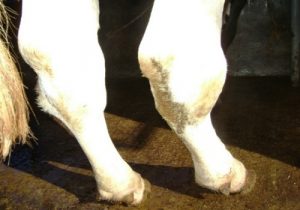 When cows are tied on a concrete floor and they are forced to sit and lie on the dirty floor which has been soiled with dung and urine. Such cows then require bathing twice a day and cleaning the floor which uses much water. In fact, the bathing of cows makes their skin more prone to diseases. Instead, cows should be brushed once every week. Cows like clean and dry places to sit and in that respect earth flooring serves best for small and medium hold farms. Researchers have proved that cow housing on concrete floors without bedding has a higher culling rate due to feet lesions and udder diseases. These types of joint diseases are more common when cows are tied all the time on the concrete floor. Such animals have poor fertility and low production. Cows like clean and dry places to sit and in that respect earth flooring serves best for small and medium hold farms. Researchers have proved that cows housed on concrete floors without bedding have a higher culling rate due to feet lesions and udder diseases. A defective animal house common in rural areas. The shed height is short, floor although earthen, is not leveled and the animal is tied most of the time.
When cows are tied on a concrete floor and they are forced to sit and lie on the dirty floor which has been soiled with dung and urine. Such cows then require bathing twice a day and cleaning the floor which uses much water. In fact, the bathing of cows makes their skin more prone to diseases. Instead, cows should be brushed once every week. Cows like clean and dry places to sit and in that respect earth flooring serves best for small and medium hold farms. Researchers have proved that cow housing on concrete floors without bedding has a higher culling rate due to feet lesions and udder diseases. These types of joint diseases are more common when cows are tied all the time on the concrete floor. Such animals have poor fertility and low production. Cows like clean and dry places to sit and in that respect earth flooring serves best for small and medium hold farms. Researchers have proved that cows housed on concrete floors without bedding have a higher culling rate due to feet lesions and udder diseases. A defective animal house common in rural areas. The shed height is short, floor although earthen, is not leveled and the animal is tied most of the time.
Tied cows Vs Loose cows
- Experiments have shown that when a cow is tied even for 2 hours blood cortisol level (which indicates stress) is 6-7 times higher than when reared loose.
- Cows kept loose on the earthen floor have higher comfort levels, better digestion of fodder, better conversion ratio and produce higher milk.
- Tied cows are more aggressive whereas cows left loose are calm and friendlier
- Cows reared loose have better fertility as these express profound oestrus signs and normal sexual behavior leading to better heat detection.
- Cows reared loose have more lactation days, higher milk production and better quality of milk.
Requirements for Cow Housing
Area required per cow: For better productivity and comfort, sufficient space must be provided in the cow housing/shed. In India, most farmers have a space constraint, and so the following standards are usually used as the minimum space needed.
| Age of Cow | Area |
| Heifer and Adult Cows | 60 – 100 square feet |
| Calves between 1 – 2 years | 30 square feet |
| Calves 1 month to one year | 25 square feet |
The following are some examples of cost-effective but comfortable barns for cows and calves. Try to use a material that is available on the farm. The design of cow housing should be minimum, without compromising animal welfare.
What is the ideal cow house layout?
Four basic principles must be kept in mind:
- Cows should always be left loose.
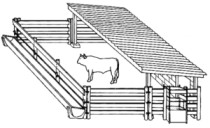 Barn floor must not be hard, should preferably be made of earth, leveled and provided with proper natural drainage for urine.
Barn floor must not be hard, should preferably be made of earth, leveled and provided with proper natural drainage for urine.- No full brick walls, but with a fence with wooden or cast iron pipes embedded in one to two feet brick/stone foundations.
- Two-thirds of the area open to sun and one-third is provided with a covered shed.
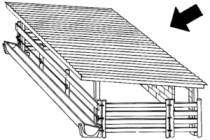 This is an ideal layout recommended by FAO suitable for the tropical warm climate with low to medium rainfall. Please note there are no walls. Feeding and water troughs are kept outside so that while serving fodder/feed or water the animals are not disturbed. Cow housing/shed is provided for the voluntary use of animals to protect from sun and rains. This is an ideal layout recommended by FAO suitable for high rainfall areas. Please note there are no walls but the fence is provided. The fence could be solid bamboo, logs or cast iron plates or even wires (do not use barbed wires used in general fencing). Feeding and water arrangements are outside so that animals are not disturbed.
This is an ideal layout recommended by FAO suitable for the tropical warm climate with low to medium rainfall. Please note there are no walls. Feeding and water troughs are kept outside so that while serving fodder/feed or water the animals are not disturbed. Cow housing/shed is provided for the voluntary use of animals to protect from sun and rains. This is an ideal layout recommended by FAO suitable for high rainfall areas. Please note there are no walls but the fence is provided. The fence could be solid bamboo, logs or cast iron plates or even wires (do not use barbed wires used in general fencing). Feeding and water arrangements are outside so that animals are not disturbed.
The following are some examples of Few cost-effective but comfortable and scientific cow housing developed by farmers in Maharashtra. Try to use a material that is available on the farm. The design of cow housing should be minimum, without compromising animal welfare.

This farmer has followed all the basic principles of scientific housing. He has used material that is available at the farm. He has provided enough space although even 50% less space would have been sufficient. Dung is removed once in three months, animals are never given a bath, nor is the floor washed, saving water as well as labour.
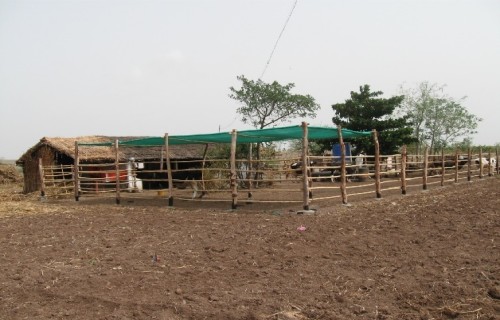
This farmer has followed all the basic principles of scientific cow housing. He has used material that is available on his farm. He has used tree sheds to provide protection from intense sun heat. Dung is removed once in a month, animals are never given a bath, nor is the floor washed, saving water as well as labour. You can see how comfortable cows are sitting and ruminating. The cows take food and water 6-7 times a day.
Cow Housing with Green Shed
This farmer is very innovative. He has used wire mesh to prevent rats, dogs, a wild animal entry in the cow house. The shed-net cover on the roof has added beauty as well as utility. Space provided is just enough. Dung is removed once in a month, animals are never given a bath, nor is the floor washed, saving water as well as labour. The cows take feed and water 6-7 times a day and spend more than 12 hours lying down and ruminating.
This cow house is not ideal but better than the tied barn. The major constraint here was space. He did not have resources to increase the height of the barn. The water and feeding arrangement is inside. But in all other respect, the cow comfort level is high, animals are clean without having to bathe. There is the saving of water.
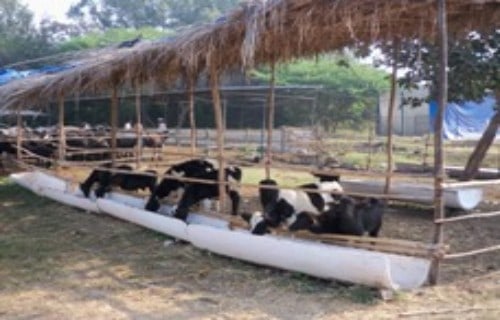
This is an economical cattle shed. Thoughtfully constructed. The feeding trough is kept outside for ease of filling without disturbing the animals. The shed provided over the feeding area protects feed and fodder from getting dry. The water trough kept inside can also be placed outside to prevent spillage of water.
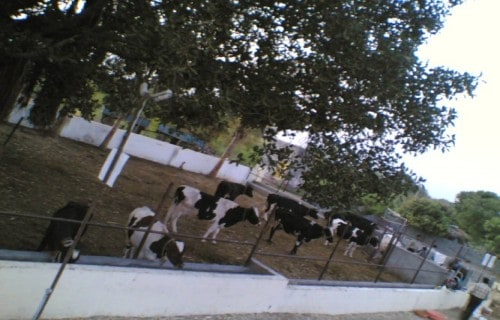
In order to provide greater protection from other animals and wildlife, the farmer has provided 2.5 – 3 feet high wall. He has used the tree shed to its maximum use. The fence wall has also been used as a feeding and water trough. Dung is removed once in a month, animals are never given a bath nor is the floor washed, saving water as well as labour. You can see how comfortable cows are sitting and ruminating. The cows take feed and water 6-7 times a day.
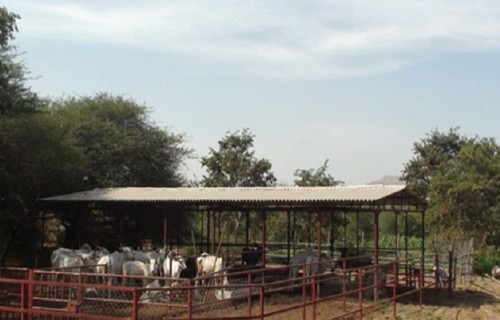
This barn has been developed by K. N. P. College of Veterinary Sciences Shirval in Maharashtra. It was feared that bulls and cows with pointed horns if housed loose in the group, might fight and injure each other. In the last five years, these animals have become more docile, easy to manage and easy to milk.

This was a model displayed in a rural livestock exhibition. The cost of construction of this bar was around INR 10,000 and is sufficient for 5-6 cows.
You may like to read More: Sandip Pawar – Successful Progressive Farmer
Dr. Abdul Samad
Ex-Dean and Director, MAFSU, Nagpur
